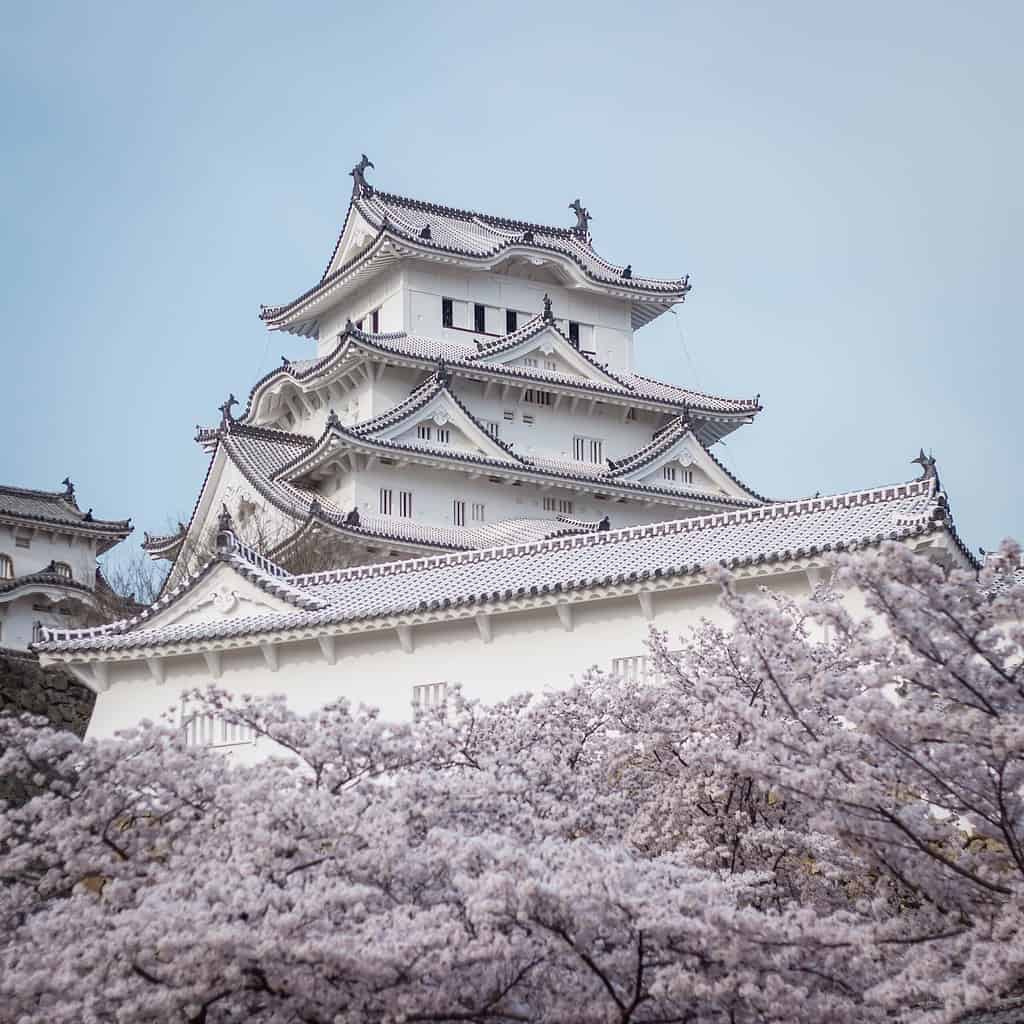Konnichiwa! Welcome to my blog post about the top 10 landmarks in Japan. As an avid traveler and lover of all things Japanese, I am excited to share with you some of the most iconic and awe-inspiring landmarks this beautiful country has to offer. From ancient temples to futuristic skyscrapers, Japan truly has something for everyone!

Planning a trip to Japan?

1. Tokyo Skytree

Our first stop takes us to Tokyo, where we’ll be mesmerized by the breathtaking Tokyo Skytree. Standing tall at a staggering height of 634 meters, this futuristic tower offers panoramic views of the bustling metropolis. Step into one of the high-speed elevators and prepare to be whisked away to an observation deck, where you’ll be treated to a jaw-dropping 360-degree view of Tokyo’s cityscape.
Tokyo Skytree is located in the Sumida ward of Tokyo, Japan. It stands in the vicinity of the historic Asakusa district, which is famous for its Senso-ji Temple and traditional atmosphere.
2. Mt. Fuji

No trip to Japan would be complete without a visit to Mount Fuji, the country’s most iconic and revered landmark. As the highest peak in Japan, Mount Fuji is shrouded in myth and legend. Whether you choose to climb it or simply admire its beauty from afar from a Ryokan in Hakone, this majestic mountain is a sight to behold. Capture the perfect postcard-worthy photo as the sun rises or sets, casting a golden glow upon its snow-capped summit.
Mount Fuji is located on Honshu Island, Japan’s main island. It straddles the border between Shizuoka Prefecture to the east and Yamanashi Prefecture to the west. Its precise coordinates are approximately 35.3606° N latitude and 138.7278° E longitude. Mount Fuji’s majestic presence can be admired from various surrounding areas, including Tokyo, Yokohama, and Hakone.
3. Kyoto’s Golden Pavilion (Kinkaku-ji)

Next on our list is the Golden Pavilion, or Kinkaku-ji, located in the historic city of Kyoto. This Zen Buddhist temple is a true architectural marvel, with its top two floors completely covered in gold leaf. As you wander through the perfectly manicured gardens, you’ll feel a sense of tranquility wash over you. It’s no wonder this serene temple is one of Japan’s most visited landmarks.
Kyoto’s Golden Pavilion is located in the northern part of Kyoto, Japan. Specifically, it is situated in the Kita ward of the city. The temple is surrounded by beautiful gardens and overlooks a tranquil pond, creating a serene and picturesque setting. Visitors to Kyoto can easily access Kinkaku-ji by public transportation or by taking a taxi.

4. Hiroshima Peace Memorial

A visit to Hiroshima is a poignant reminder of the devastating events of the past and the enduring spirit of resilience. The Hiroshima Peace Memorial, also known as the Atomic Bomb Dome, stands as a powerful symbol of hope and peace. This preserved building serves as a memorial to the victims of the atomic bombing and is a UNESCO World Heritage Site. Take a moment to reflect on the importance of peace and the resilience of humanity.
The Hiroshima Peace Memorial is located in Hiroshima, Japan. It stands in the Hiroshima Peace Memorial Park, which is situated in the Naka ward of the city. The park and memorial are located near the Motoyasu River, offering a peaceful and reflective environment. Hiroshima can be easily reached by train or air transportation.
5. Himeji Castle

Prepare to be transported back in time as we explore Himeji Castle, a magnificent fortress perched atop a hill in Himeji. Often referred to as the White Heron Castle due to its elegant white exterior, this UNESCO World Heritage Site is a masterpiece of Japanese castle architecture. Wander through its maze-like corridors, climb to the top of the main keep for panoramic views, and immerse yourself in the history and grandeur of this ancient stronghold.
Himeji Castle is located in Himeji City, Hyogo Prefecture, Japan. The castle is situated on a hilltop, offering a commanding view of the surrounding area. Himeji City is easily accessible by train from major cities like Osaka and Kyoto, making it a popular day-trip destination for visitors to the region.
6. The Floating Torii Gate – Itsukushima Shrine (Island of Miyajima)

A true marvel of nature and architecture, the Itsukushima Shrine is located on the island of Miyajima. As you approach this Shinto shrine during high tide, you’ll be greeted by the enchanting sight of the iconic floating torii gate, seemingly rising from the sea. This UNESCO World Heritage Site exudes a serene beauty that will leave you breathless. Take a leisurely stroll through the shrine’s vermilion-colored corridors and admire the harmonious blend of land and sea. As one of Japan’s most photographed landmarks, this vermilion gate appears to float on the water during high tide, creating a truly magical sight. During low tide, you can walk right up to the gate and admire its intricate details up close. As the sun sets, the gate casts a mesmerizing reflection on the calm waters, making for a picture-perfect moment.
The Floating Torii Gate is located on the island of Miyajima in Hiroshima Prefecture, Japan. Miyajima, also known as Itsukushima Island, is situated in the Seto Inland Sea, southwest of the city of Hiroshima. Visitors can reach Miyajima by taking a ferry from the Miyajimaguchi Port, which is easily accessible from Hiroshima by train or tram.
7. The Great Buddha of Kamakura

Venturing out to Kamakura, we encounter the Great Buddha, a towering bronze statue that stands at over 13 meters tall. This majestic icon is a testament to Japan’s rich Buddhist heritage. As you stand in its presence, you can’t help but feel a sense of awe and wonder at the sheer size and serenity of this magnificent statue. Take a moment to appreciate the intricate details, from the folds of the Buddha’s robes to the peaceful expression on its face. The Great Buddha of Kamakura is a true representation of the country’s spiritual and artistic prowess.
The Kamakura Buddha is located in the city of Kamakura in Kanagawa Prefecture, Japan. Kamakura is a historic city known for its temples, shrines, and rich cultural heritage. Kamakura is easily accessible from Tokyo by train, and visitors can enjoy the scenic beauty and historical attractions of the city along with the majestic presence of the Great Buddha.
8. Nara Park (Kyoto)

Prepare to be charmed by the adorable residents of Nara Park, as well as the historical landmarks that dot its landscape. This expansive park is home to over a thousand friendly deer that roam freely and interact with visitors. Be sure to pay a visit to Todai-ji, a grand Buddhist temple and another UNESCO World Heritage Site. Inside the temple, you’ll find the Daibutsu, a colossal bronze statue of Buddha that is truly awe-inspiring.
Nara Park is located in the city of Nara, Nara Prefecture, Japan. The park is a large, open area that covers approximately 502 hectares and is home to numerous historical and cultural landmarks. It is situated in the heart of Nara, making it easily accessible for visitors. The park is known for its friendly deer population, beautiful cherry blossom trees, and significant attractions such as Todai-ji Temple and Kasuga Taisha Shrine. Nara can be reached by train from major cities like Kyoto and Osaka, and Nara Park is a must-visit destination for those exploring the city.
9. Osaka Castle

In the vibrant city of Osaka stands a castle that has witnessed centuries of history and stands as a symbol of power and resilience. Osaka Castle, with its towering walls and elegant architecture, invites you to delve into the city’s past. Explore the museum inside the castle to learn about its rich heritage and climb to the top for a panoramic view of the surrounding cityscape. Osaka Castle is a testament to Japan’s samurai legacy and a must-visit landmark.
Osaka Castle is located in the Chuo ward of Osaka City, Osaka Prefecture, Japan. The castle stands proudly in the center of Osaka and is one of the most famous landmarks in the city. Its strategic location offers panoramic views of the surrounding area. Visitors can easily reach Osaka Castle by public transportation, including the subway or bus, as it is well-connected to the city’s transportation network. Osaka is a vibrant and bustling city, and a visit to Osaka Castle is a must for those exploring the cultural and historical attractions of the area.
10. Arashiyama Bamboo Grove (Kyoto)

Step into a world of tranquility and enchantment as you enter the Arashiyama Bamboo Grove in Kyoto. The towering bamboo stalks create a surreal and ethereal atmosphere, transporting you to a different realm. Take a leisurely stroll through the grove and let the rustling of the bamboo leaves soothe your soul. The beauty and serenity of this natural landmark make it a favorite spot for photographers and nature lovers alike.
The Arashiyama Bamboo Grove is located in the district of Arashiyama in Kyoto, Japan. Arashiyama is a picturesque area known for its natural beauty and historical sites. The Bamboo Grove is situated in the western part of Arashiyama, near the iconic Togetsukyo Bridge. Visitors can easily access the Bamboo Grove by taking a train or bus to Arashiyama Station and then walking a short distance to the grove. The towering bamboo stalks create a serene and otherworldly atmosphere, making it one of the most popular attractions in Kyoto.
Summing It Up
And there you have it, my fellow travelers, the top 10 landmarks in Japan that will leave you in awe of this incredible country’s rich history, natural beauty, and architectural marvels. From the futuristic heights of Tokyo Skytree to the ancient serenity of Kyoto’s temples, each landmark tells a story and leaves an indelible impression. So, pack your bags, embark on your own adventure, and immerse yourself in the wonders of Japan. Sayōnara and happy exploring!
Disclaimer: If you use the link on this page to purchase travel insurance, we will receive a fee from Freely, a brand of Cover-More Insurance Services Pty Limited ABN 95 003 114 145 (AFSL 241713) (Cover- More). We do not act for Cover-More or Freely. The information provided is only on the availability of Freely products. We do not give advice & the information provided is not intended to give an opinion or recommendation regarding the product. For information on how to contact Cover-More or Freely refer to the PDS, FSG & TMD which can be found on the Freely website.



